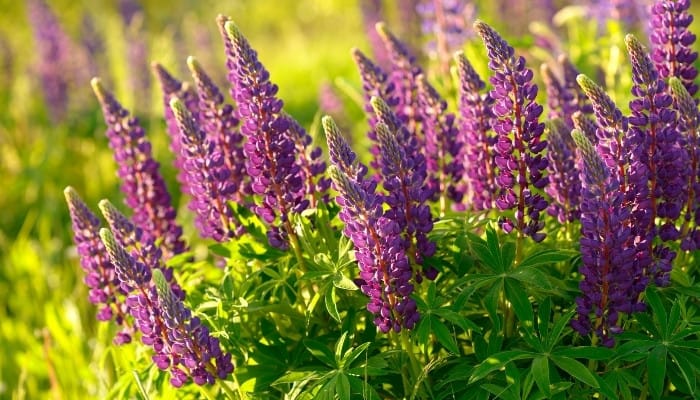Some potential ways to rephrase the text without changing the original meaning and sentiment are:
– Lupins, known for their vibrant spikes, are well-liked flowers that typically blossom during the spring and summer months. The type of lupin and location it is planted in determine whether it will grow as an annual or perennial plant.
– A favorite among flower enthusiasts, the lupin produces striking spiky blooms in the warmer months of spring and summer. Lupins can either be annuals or perennials, depending on the location and species of the plant.
– With their colorful spikes, lupins are a popular choice for flowers that thrive in the spring and summer. The type and placement of lupin species ultimately determine if they will grow as annuals or perennials.
– Lupins, highly sought-after for their eye-catching blooms, are commonly found in gardens during the spring and summer seasons. If you are wondering whether your lupins will grow back each year, it depends on the specific kind of lupin and where it is planted.
– The spring and summer months see a rise in the popularity of lupins, identifiable by their showy, spiky flowers. Whether a lupin will return year after year or just bloom for one season depends on the type of plant and where it is located.
If you encounter any difficulties while trying to rewrite the text, please respond with the message:
“Unable to process the request due to encountered difficulties.”
How can you get lupines to flower? To encourage lupins to flower, apply a high-phosphorus fertilizer, deadhead spent flowers, check for pests and disease routinely, and provide the best growing conditions as possible, such as watering consistently and ensuring the plants are receiving adequate light.
You’ll need to create the right conditions for these flowers to thrive. Lupins do well in environments with plenty of sun exposure, water, and good drainage.
The soil should be rich and neutral, and you should check for pests and diseases regularly to create a healthy environment.
A high-phosphorus fertilizer can help with growth and flower production, and you can encourage more growth by deadheading flowers that start fading.
Read on to learn more about caring for these flowers.
How To Get Lupins To Flower
Lupins were originally wildflowers. You can find hybrids bred for their colorful shoots and hardiness.
Overall, most varieties are easy to care for, but you can do a few things to help these flowers bloom.
1. Apply a High-Phosphorus Fertilizer
Phosphorus is an essential mineral that supports energy transfer and photosynthesis. Flowers also need phosphorus to produce buds.
There is no need to use a high-phosphorus fertilizer if your soil already has enough phosphorus. However, you can promote blooming by applying a high-phosphorus fertilizer if phosphorus levels are low on your property.
Look for signs of phosphorus deficiency that include dark or pale leaves, red or violet coloration on the leaves, and slow growth.
2. Deadhead Lupins as Soon as Flowers Fade
Most lupin varieties bloom during the spring and summer. At the end of the summer, the flowers will start fading. They will eventually dry and release seeds.
You should deadhead lupins as soon as you see the flowers fade.
You can cut the spike with some garden shears. More stems will grow, and you will get a second bloom for a few additional weeks.
Deadheading lupins is important because seeds can fall and cause more flowers to grow and compete for water and nutrients. Besides, lupin seeds can be poisonous to pets and wildlife.
3. Check for and Treat Pests Regularly
Several pests can affect lupins, including:
- Snails and slugs.
- Spider mites.
- Mealybugs.
- Gnats.
- Whiteflies.
- Aphids.
- Blister beetles.
Insects like aphids will suck the sap out of the flowers and cause them to become dry. Plus, these insects produce waste that promotes fungal growth.
Look for signs of chewing and damage on the leaves. You might be able to see the insects.
You can protect lupins with pesticides or by coating them with horticultural oils. Introducing natural predators like lady beetles or lacewings is another possible option.
4. Inspect Often To Spot Signs of Disease
Lupins are susceptible to viruses, rot, and fungus. All these diseases can prevent blooming.
Look for common symptoms like cankers, brown or dried leaves, unusual stem growth, stunted plants, or cotton-like fungus.
You can remove the affected parts or cut the entire plant to prevent the disease from spreading.
5. Water Consistently
Lupins do well in moist soil, but you need to provide good drainage to prevent root rot. The general consensus is to water every three to four days.
6. Make Sure Lupins Are Receiving Enough Bright Light
These colorful flowers need full sun exposure. They can grow in Zones 4 through 8, but you might want to provide some minimal shade in Zone 9.
Best Lupin Varieties to Grow

The Lupinus genus is incredibly varied. It includes over 200 species of wildflowers and several hybrids.
You can grow different varieties to add color to your landscaping project:
- Large-leaved lupin is a robust perennial that grows large spikes of flowers. It can reach 3 to 5 feet in height.
- Lupinus albus ‘Cashmere Cream’ grows tall, white flowers in June.
- Lupinus arboreus or yellow bush lupin is an evergreen shrub that will add volume to your flower beds.
- Lupinus ‘Terracotta’ is a popular variety thanks to its colorful red and orange flowers that bloom from May to July.
- Russell hybrid lupins are another popular option. These hybrid flowers grow from May to June and can reach 30 to 36 inches in height. They can be blue, yellow, pink, purple, red, or white.
- The Arroyo lupine is a variety that is native to California. It’s an annual plant with purple flowers.
- The Riverbank lupin is a wildflower that grows fast, and that can reach 5 feet in height.
- Miniature lupins are annual or perennial flowers native to the Western U.S. They typically don’t exceed 16 inches in height.
- European yellow lupins are native to Southern Europe. These bright yellow flowers are great for attracting pollinating insects.
- Arctic Lupins grow blue or purple pea-like flowers. These plants are typically 24 inches tall.
Tips for Growing Lupins in Pots
You can grow lupins in pots if you use large containers. You should know that growing these plants in containers can make them more vulnerable to pests and diseases.
Keep your potted lupins in a spot where insects won’t get to them.
You’ll get better results if you use loam-based compost with good drainage. Remember to deadhead old spikes as soon as they fade and keep the soil moist.
You can use fertilizer, like this slow-release feed, to support blooming, but you should use small quantities when growing lupins in containers since high phosphorus levels can have adverse effects.
Related Questions:
Here are a few additional things to know about caring for lupins.
How Long Does It Take Lupins To Flower?
The amount of time for lupins to flower depends on when you plant them. You’ll see blooms in the spring, but lupins might miss a flowering season if you plant them too late.
Ideally, you should grow them from seeds indoors for six to eight weeks before planting them outdoors in the spring. You can also plant them from seed outdoors in the fall to get them to flower in the spring.
Do You Cut Back Lupins in Autumn?
You should prune lupins at the end of the summer. You should cut the main stem once you see the flowers fade. More side stems will grow.
You can cut these smaller stems in the autumn to stimulate healthy growth in the spring.
Wrapping It Up
Lupins are easy to care for, but remember that these flowers need plenty of sunlight and moist soil with good drainage.
Watch out for pests and diseases, and make sure you cut stems as soon as the flowers fade to stimulate new growth.
Sources:
https://homeguides.sfgate.com/fertilizer-element-encourages-flowering-growth-plants-76453.html
https://homeguides.sfgate.com/deadhead-lupines-98038.html
https://homeguides.sfgate.com/lupines-bloom-first-year-68788.html

